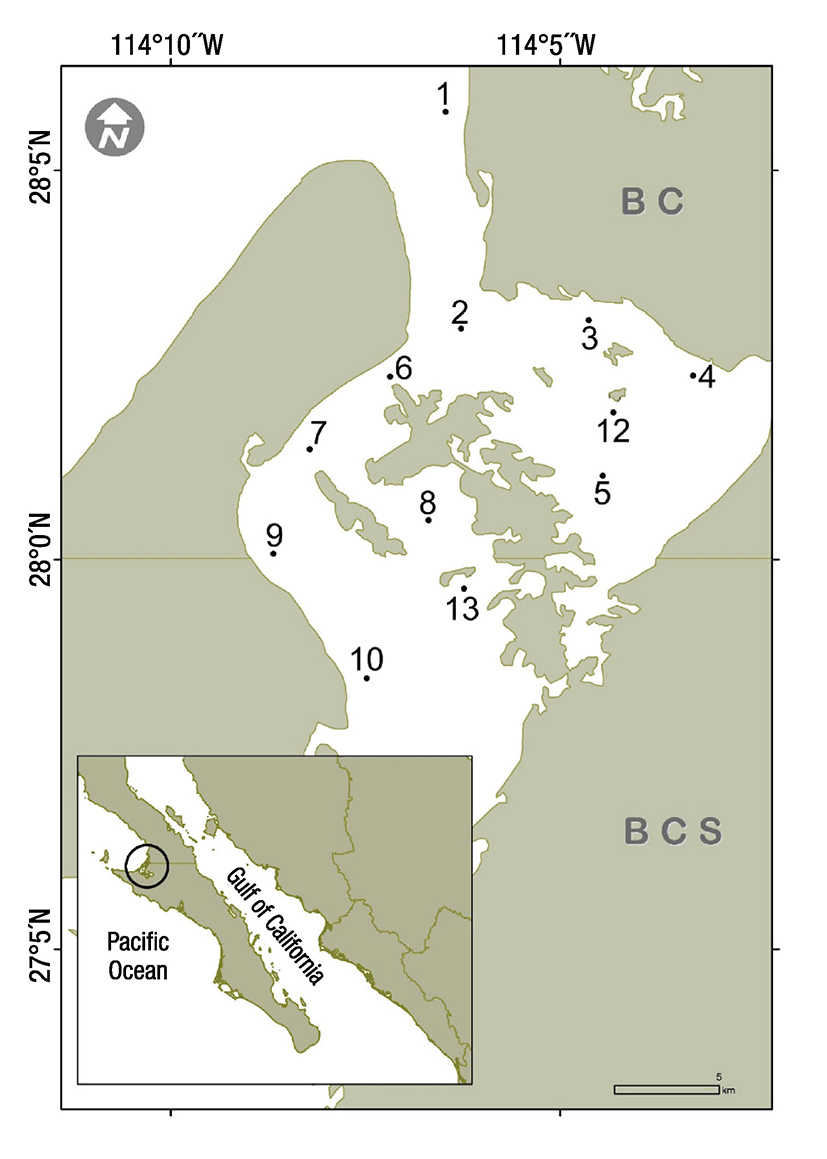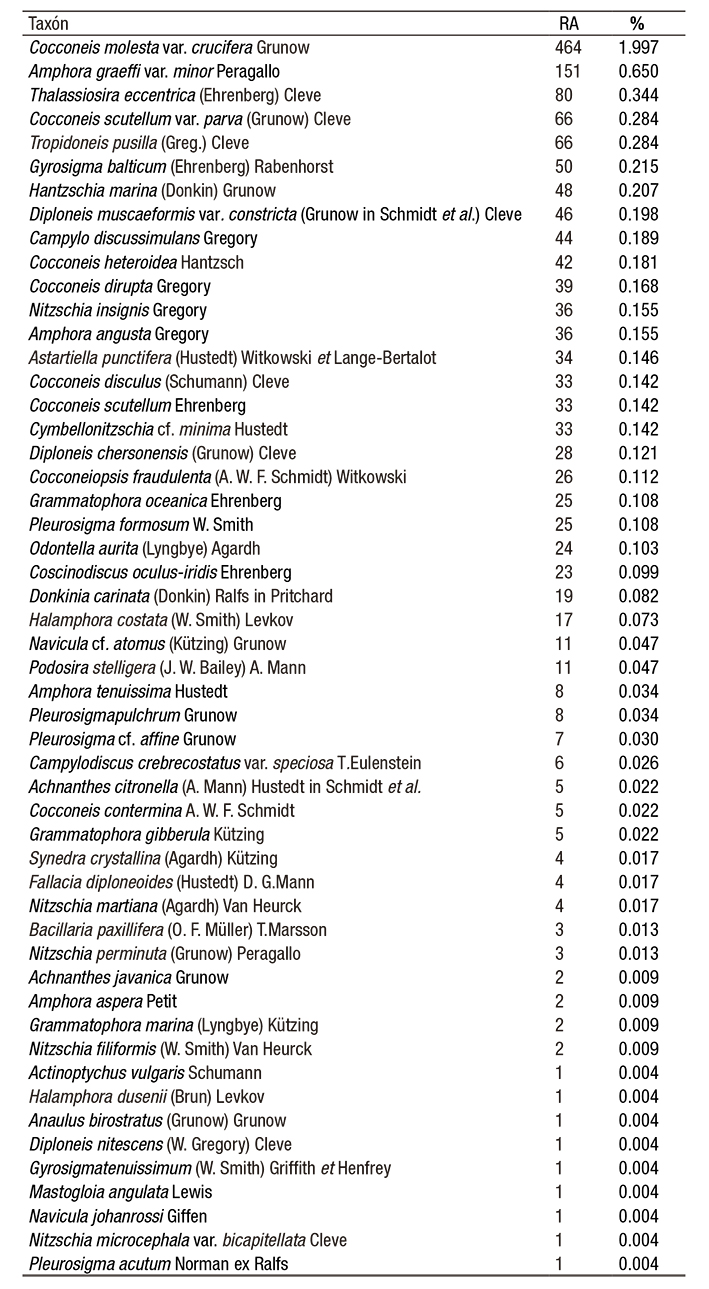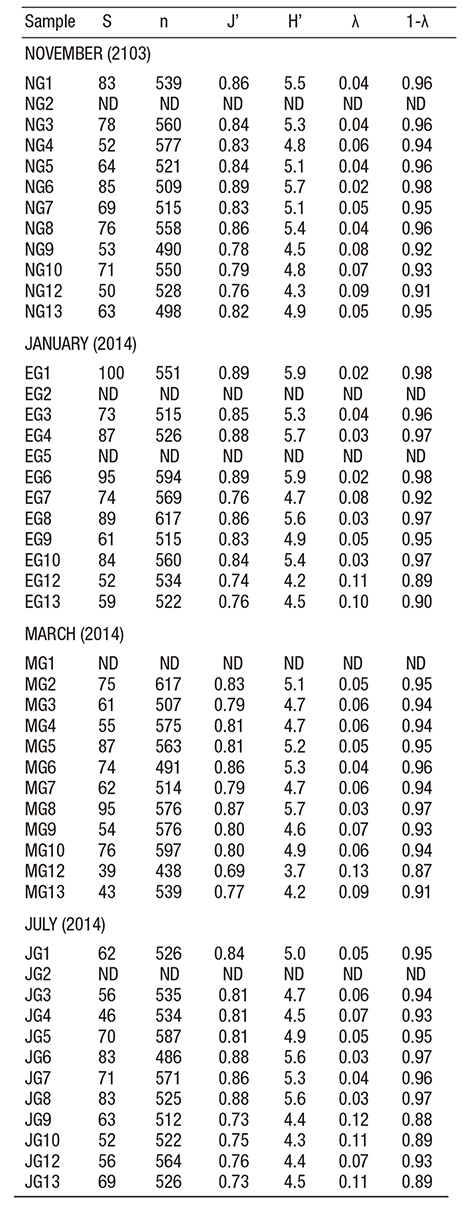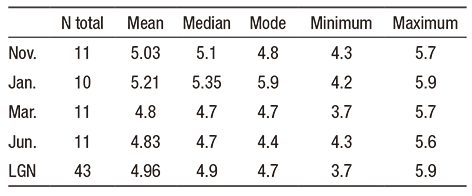Introduction
Although protected areas are strategic for the conservation of species and their habitats, there are still doubts regarding their effectiveness. Thus, the premise that such measures are effective in conserving species was recently put to the test (Gray et al., 2016). These authors observed that within-sample species richness could be significantly higher inside than outside protected areas. Laguna Guerrero Negro, Baja California - Baja California Sur, Mexico (LGN) is a protected coastal lagoon for which very few ecological studies are available. Since the survey by Eberhard (1966), only recently has an interest in describing benthic biocenoses emerged, including macrobenthos (Morales-Zárate et al., 2016) and microbenthos focusing on diatoms (Siqueiros Beltrones et al., 2017a, b). Considering that benthic diatoms are an important food source for bivalve mollusks (Siqueiros Beltrones, 2002a), and several species of clams and oysters sustain important fisheries in LGN (Morales-Zárate et al., 2016), ecological studies on these microalgae are needed in order to generate baseline data for their management.
In addition, benthic diatoms are an adequate reference for measuring biodiversity, in part because of their high species richness. In LGN, high species richness of benthic diatoms was estimated for subtidal sediments, which included 14 new species records and 24 unidentified species (Siqueiros Beltrones et al., 2017a), plus the highest number of Lyrella species for a locality in the Mexican NW region (Siqueiros Beltrones et al., 2017b). The generated species list is a baseline for further ecological and biogeographical studies that are indispensable for protecting areas in order to preserve biodiversity and support decision making. By using the available diatom floristics as a reliable reference for estimating the relative or proportional abundances of the taxa, calculation of ecological parameters can follow to better describe the assemblages, inasmuch as community studies through joint analyses of classical parameters such as species richness, diversity, dominance and equitability, can help to detect patterns in taxocoenoses that can reflect ecological status such as in assemblages from extreme environments or that reflect environmental impact (Siqueiros Beltrones, 2002b). Based on these parameters, however, few attempts have been made to detect environmental impact, (e.g., due to potentially toxic elements), by examining the structure of the diatom associations allegedly exposed to the former (Siqueiros Beltrones et al., 2014). Also, a comparison of the structure of benthic diatom assemblages can be used as a reference for assessing environmental conditions in protected areas.
Typical diatom assemblages are characteristically composed of a few abundant and very common species, and many rare and uncommon species. This situation is reflected in the mathematical diversity values derived from information theory calculated with Shannon’s index (H´), which has been observed to vary, mainly between modal values of 2.6 - 3.8 bits/taxon (median, 2.4-4.6) for microphytobenthic assemblages (Siqueiros Beltrones, 1998).These have been interpreted as usual or moderately high values of diversity that depict stability of the assemblages and, although higher (H´≤5) and lower (H´< 2) values are not uncommon, these in turn have been interpreted as indicative of a tendency towards an improbable and thus unstable state of the assemblages in nature (Siqueiros Beltrones, 2005).
However, more recent studies on the structure of benthic diatom assemblages for the Mexican NW region have yielded further reference values, e.g., extreme low (uncommon) values (H´< 2) were recorded for epiphytic diatom assemblages living on blades of the kelp Eisenia arborea J.E. Areschoug (Siqueiros Beltrones et al., 2016); and previously, similar values (average H´= 2.1) were estimated for diatom epiphytes living on blades of another kelp, Macrocystis pyrifera (Linnaeus) C. Agardh (Argumedo Hernández & Siqueiros Beltrones, 2008). As a comparison, other studies in the region have produced mean values of diversity of up to H = 4.76 in diatom assemblages from mangrove sediments (López Fuerte & Siqueiros Beltrones, 2006), and, later, from H´ = 4.58 to H´ = 5.13 for different substrata (Hernández Almeida & Siqueiros Beltrones, 2008, 2012). All of the above apply to undisturbed coastal environments.
In the case of LGN, the observed high number of species and subspecies taxa (S) of epipelic diatoms is considered typical of highly productive environments (Siqueiros Beltrones et al., 2017a), where the values of species diversity based on proportional abundances, e.g., H´ are also usually high (Siqueiros Beltrones, 2002a).
Based on the above, the aim of this study was to describe the structure of the epipelic diatom assemblages living in subtidal sediments of LGN, and contrast the hypothesis that diversity values estimated on the basis of information theory (H´) would be higher than the median value of H´ calculated for benthic diatom assemblages from other localities (Siqueiros Beltrones, 2005), and at least as high as the upper values recorded in the more recent studies cited above.
Materials and methods
Study area. Laguna Guerrero Negro (LGN) is part of a lagoon complex together with Laguna Ojo de Liebre (Figure 1) located (27° 35´ and 27° 52´ N and 113° 58´ 114°10´ W) on the Baja California peninsula, between B.C. and B.C.S., Mexico within the El Vizcaino Biosphere Reserve (Arellano Martinez et al., 1996). Its maximum length is13 km and maximum width is 8 km (Contreras, 1985), with a shallow bottom that varies in depth between 2-12 m (Lluch et al., 1993). Eelgrass (Zostera marina Linnaeus) is widely distributed from six meters deep up to the high tide mark (Eberhard, 1966). Lagoon sediments are mainly grey sand and organic alluvial deposits. Normal and hypersaline salinity gradients have been recorded (Lankford, 1977), although it has been considered an isohaline lagoon with salinities between 35.5-37.5 in winter, and 34.7-35.6 in summer (Phleger & Ewing, 1962).

Figure 1 Location of the twelve sampling sites in Laguna Guerrero Negro, B.C. -B.C.S., Mexico. No site 11
Sample processing. During November 2013, January, March, and July 2014, sediment samples (150 g each) were collected by scuba divers using plastic bags at twelve sites in the subtidal bottom of Laguna Guerrero Negro (1-13); site 11 was not considered because of logistic difficulties but numeration was kept in reference to other studies. (Figure 1). Samples were then processed and mounted with Pleuraxon 48 permanent slides. These were used to prepare a floristic list of epipelic diatoms (Siqueiros Beltrones et al., 2017a). The slides were then examined under a compound microscope with phase contrast at 1000x for a quantitative analysis. New taxa were identified (Peragallo & Peragallo, 1897). Their taxonomic status was updated according to the Algaebase web site (http://algaebase.org/search/species/ (Guiry & Guiry, 2017), and the Fourtanier & Kociolek (2017) Catalogue of Diatom Names of the California Academy of Sciences (CAS) web site http://researcharchive.calacademy.org/research/diatoms/names/. These, together with the previous floristic list, were used as a reference to count 500 diatom valves (n) in each slide in order to determine the relative abundance (RA) of each taxon. Said abundance was used to estimate community parameters of the assemblages, such as species diversity, equitability, and dominance. Species diversity values were calculated based on information theory using Shannon´s H´ and Pielou´s J´, both with log2 (Brower et al., 1998). We thus used bits/taxon (not bits/individual) as units, as a measure of uncertainty for a randomly collected specimen in a taxocoenosis, for it to belong to a certain (specific or infra-specific) taxon (Siqueiros Beltrones, 2005). Simpson´s indices of dominance and diversity (λ, 1- λ) were also used; these measure the probability that two specimens collected at random belong to the same or different species (Brower et al., 1998).
To test our hypothesis, two approaches were followed: 1) a 99% bias-corrected and accelerated (BCA) bootstrap confidence interval was constructed for the median H´ value of benthic diatom assembla ges compiled in Siqueiros-Beltrones (1998); and 2) we compared the median values of said data vs. the median value of H´ calculated for Laguna Guerrero Negro. Because of the high dispersion shown by the H´ values and common occurrence of outliers, we chose to use the median and thereafter non-parametric statistical techniques. This confidence interval and the Kruskal-Wallis test for significance were done using the statistical IBM© SPSS© 23 software, and a Mann-Whitney test, using Origin Pro© 9 software. For the Mann-Whitney test, the null hypothesis was that LGN H’ median values were not significantly different than tho se of typical microphytobenthos assemblages. Both the Kruskall-Wallis and Mann-Whitney tests were performed at an a = 0.01. A similarity matrix between samples was also computed using presence/absence of species (Jaccard index) and another also using their relative abun dances (Bray-Curtis index).
Results
A total (N) of 23,325 diatom valves were counted. These included 225 taxa, out of which 52 are new additions to the LGN diatom flora (Table 1), 46 were previously recorded elsewhere for the Mexican NW region, and six were new records for Mexican littorals (Siqueiros Beltrones & Argumedo Hernández, 2017). Thus, species richness for the LGN sediments rises to 285 taxa, with 117 of these comprising 95% of the total relative abundance. Five samples could not be quantified because of the low valve abundance in the slides (Table 2). Relative abundances of the identified diatom taxa were distributed as expected with few abundant and common taxa, and many rare and uncommon species. The pennate forms Amphora exilitata Giffen and Navicula bipustulata A. Mann were the most abundant taxa (>1000 valves); 29 taxa were very common (≥ 200); 57 taxa were considered common <200 ≥ 50; and 137 were considered rare (<50). Rare species in this study represent >60% of the taxa accounted for (Table 1); these, plus the 52 not recorded in the previous floristics, total to 189 rare taxa for the LGN over all benthic diatom taxocenoses.
Table 1 New (52) subtidal epipelic diatom taxa and their relative abundances (RA) and percentage RA (%) in Laguna Guerrero Negro, B.C.-B.C.S., Mexico (N=23,325).

Table 2 Estimated community parameter values for benthic diatom assemblages from Laguna Guerrero Negro (G), BC-BCS, Mexico. N = November; E = January; M = March; J = July; S = species richness; n = sample size; J´ = equitability (bits/taxon); H´= Shannon´s diversity (bits/taxon); λ = Simpson´s dominance (probability); 1-λ = Simpson´s diversity. ND = not determined. No site 11.

Species richness (S) among the samples varied between 50 and 100 taxa, with over 70% of the samples having a S > 60; which can be considered a high species number for benthic diatoms assemblages. Overall, 46 % of the samples showed H´ values higher than 5 bits/taxon (Table 2), with an average value of 4.96 and a median of 4.9. Values ranged from 3.7 - 5.9, the former being the only calculated H´ value under 4 (Table 2), vs. the calculated median value for the microphytobenthic assemblages (Md = 3.7) used as a reference. Although values of H´ > 5 were frequent, in January we found the highest diversity (H´= 5.9) twice, which is much higher than the mean value for the whole lagoon (Table 3). Even though such frequency seemed more characteristic of the cool season (November-January) than for the warm season (March-July), the Kruskal-Wallis test did not detect significant differences between the monthly median values of H´ in LGN (c2(3) = 3.842, p>0.01). Thus, differences in the calculated values of H´ are considered within the range of random variations.
Table 3 Statistical parameters for the calculated values of H´ of benthic diatom assemblages from Laguna Guerrero Negro (LGN), Mexico. N = number of samples.

On the other hand, the monthly median values of H´ for LGN benthic diatom assemblages (Table 3) surpassed the 99 % bootstrap CI [3.52 - 3.81] constructed for the H’ median value of microphytobenthic assemblages. Therefore, we see that monthly median diversity estimated for the LGN assemblages is indeed higher. These results were confirmed by the Mann-Whitney test which indicates that H’ values were significantly higher for LGN (Md = 4.9) than for typical microphytobenthos assemblages (Md = 3.7), U=10935.5, p <0.01, thus confirming our hypothesis.
The overall high values of H´ correspond to the high number of species (S) in most of the samples, but there is also a correspondence with high values of equitability, and with the values of Simpson´s indices (diversity and dominance), which are less sensitive to rare taxa. This indicates that the high diversity values were due to a higher number of more common taxa rather than to rare species. All this is in accordance with the proposed hypothesis.
Measurements with both similarity indices ranged between 45% and 60% that comprised most of the samples (Figures 2-3). No patterns were apparent within dendrograms, confirming a lack of statistical differences between monthly H’ values. The only exception is the group of four samples from site 6 with Bray-Curtis. However, when compared with Jaccard values, it is evident that the same (few) abundant species were present at this site during all dates, while also sharing high values of equitability, which confirms that a significant number of common taxa were similarly distributed at these sites. Spatially, however, sites differed in overall species composition at around 50%. All these observations from the similarity analysis corresponds to the typical patchy distribution of taxa usually observed in benthic diatom assemblages.

Figure 2 Jaccard similarity values in benthic diatom species composition between all samples collected at Laguna Guerrero Negro, B.C. -B.C.S., Mexico. The low values suggest the typical patchy distribution of the taxa in benthic diatom assemblages

Figure 3 Bray-Curtis similarity values in benthic diatom species composition between all samples collected at Laguna Guerrero Negro, B.C. - B.C.S., Mexico. The patchy distribution of benthic diatom taxa suggested in general by low values (although higher than with Jaccard) combines with high values that are caused by the shared presence of taxa with high relative abundances in several sites, e.g. 6, 12, 13.
Discussion
Almost as many taxa (225) were included in this quantitative analysis of the epipelic diatom assemblages of LGN as those recorded (232) in the supporting floristic study (Siqueiros Beltrones et al., 2017a). Of the 52 additions to the LGN diatom flora, 46 taxa were previously recorded elsewhere for the Mexican NW region, while six taxa turned out to be new records for the Mexican littorals: Achnanthes citronella (A. Mann) Hustedt; Amphora graeffi var. minor Peragallo; Navicula (Cocconeiopsis?) aspersa Hustedt; Diploneis muscaeformis var. constricta (Grunow in Schmidt et al.) Cleve, Pleurosigma affine Grunow; Pleurosigma pul chrum Grunow (Siqueiros Beltrones & Argumedo Hernández, 2017). This, along with the low similarity values demonstrates the typical patchy distribution of benthic diatoms that causes floristics in discrete surveys to be underestimated.
On the other hand, the high number of diatom species (S) per sample and their proportions (J’) are reflected in the estimated mean values of diversity (H´) in sediments of LGN, some of which are among the highest ever recorded in the Mexican NW region (Jan H´ = 5.2 bits/taxon), and much higher than the a for mentioned median values that allegedly reflect stability (Siqueiros Beltrones, 2005), and higher than those within the confidence interval constructed in this paper. Although this could suggest that the LGN assemblages may not be stable (Siqueiros Beltrones, 2005), recent studies in undisturbed coastal localities report similar mean values of diversity (H´ = 4.76 bits/taxon) in mangrove sediments from Bahía Magdalena (López Fuerte & Siqueiros Beltrones, 2006). Besides, these authors recorded the most taxa hitherto for a single locality in NW Mexico (S = 325) in a previous floristic phase, while in the quantitative phase, the number of taxa per sample ranged from 64 to 119 in 11 of their 12 samples (S = 251). They attributed the high estimated values of species diversity (H´) to the better represented taxa, rather than to overall species richness, although they did record a larger proportion (68.5%) of rare species (172), with 83 taxa accoun ting for 95% of the relative abundances. Also, Hernández Almeida and Siqueiros Beltrones (2008; 2012) estimated high mean values of H´ = 4.58 and H’= 5.13 for epilithic and epiphytic assemblages, respecti vely. In the former case, 55 epiphytic taxa on macroalgae comprised 95% (N=211) of the RA. In contrast, in seagrass epiphytes, 25 taxa (S =115) comprised 95% of the RA, with corresponding H´ values of 3.42-4.15 Siqueiros Beltrones et al. (1985). Compared with the 117 taxa in this study, it seems evident why the values of H´ in LGN were significantly higher. The above values, coupled with the distribution of relative abundances, species richness, the patchy distribution suggested by the new taxa, and the similarity values are typical of benthic diatom taxocoenoses from undisturbed environments. The high species diversity of benthic diatom assemblages observed for LGN is what we would expect to find in a protected area. However, Gray et al. (2106) observed that within-sample species richness could be significantly higher inside than outside protected areas, but they did not find consistency in their observations when using rarefaction-based species richness. In our study, the high number of benthic diatom taxa and their proportions suggest that analyzing the structure of benthic diatom taxocoenoses may prove useful as an alternative for direct rarefaction techniques that permits reliable comparison between different taxocoenoses. Moreover, community parameter values could be used for assessing environmental impact or as a reference for characterizing undisturbed conditions in marine environments (Siqueiros Beltrones et al., 2014a). Thus, on the basis of the present structure of the benthic diatom assemblages from LGN, no environmental impact, either natural or anthropogenic, is suspected at this lagoon, and we expect these characteristics to be similar for benthic diatom assemblages in other undisturbed subtropical coastal lagoons.











 nueva página del texto (beta)
nueva página del texto (beta)


